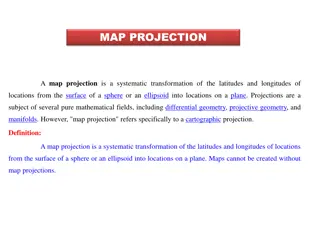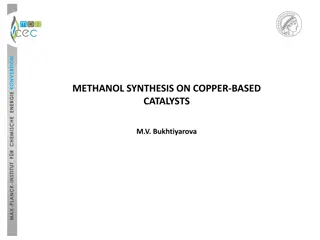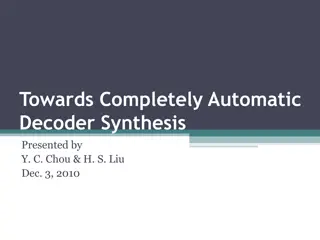Understanding Model-Based Projection Synthesis Theory and Practice
Explore the theory and practical application of Model-Based Projection Synthesis (MBP) in solving problems related to quantifier elimination, validity of first-order logic fragments, and witness synthesis. Learn about solving existential quantifier sentences and extracting witnesses in the context of Functional Reactive Synthesis.
Download Presentation

Please find below an Image/Link to download the presentation.
The content on the website is provided AS IS for your information and personal use only. It may not be sold, licensed, or shared on other websites without obtaining consent from the author. Download presentation by click this link. If you encounter any issues during the download, it is possible that the publisher has removed the file from their server.
E N D
Presentation Transcript
Model Based Projection + Synthesis: Theory and Practice (What works and what doesn t) Stanly Samuel 26 May 2021
Overview: Model Based Projection (MBP) (Quantifier Elimination) Solving AE using MBP (Validity of AE Fragment of FOL and synthesizing a witness) Application of AE solving to Synthesis: Functional Reactive
Background and Intuition: Solving a sentence containing Existential Quantifier: If True, return a witness x. x2= x + 6
Background and Intuition: Solving a sentence containing Existential Quantifier: If True, return a witness x. x2= x + 6 x y. [0<=x<=10 => (y = x + 1 and y <=5) ]
Background and Intuition: Solving a sentence containing Existential Quantifier: If True, return a witness x. x2= x + 6 x y. [0<=x<=10 => (y = x + 1 and y <=5) ] x y. (0<=x<=10 => y = x + 1)
Background and Intuition: Solving a sentence containing Existential Quantifier: If True, return a witness x. x2= x + 6 x y. [0<=x<=10 => (y = x + 1 and y <=5) ] x y. (0<=x<=10 => y = x + 1)
Background and Intuition: Extracting a witness for: x y. (0<=x<=10 => y = x + 1)
Background and Intuition: Extracting a witness for: x y. (0<=x<=10 => y = x + 1) x. (0<=x<=10 => f(x) = x + 1)
Background and Intuition: Extracting a witness for: x y. (0<=x<=10 => y = x + 1) x. (0<=x<=10 => f(x) = x + 1) Theory of UF + T (LIA) + Universal Quantifier
Background and Intuition: Extracting a witness for: x y. (0<=x<=10 => y = x + 1) x. (0<=x<=10 => f(x) = x + 1) Theory of UF + T (LIA) + Universal Quantifier Synthesize a function f which satisfies the formula (specification) on ALL inputs denoted by x. Functional Synthesis!
Background and Intuition: Extracting a witness for: x y. (0<=x<=10 => y = x + 1) x. (0<=x<=10 => f(x) = x + 1) Theory of UF + T (LIA) + Universal Quantifier Synthesize a function f which satisfies the formula (specification) on ALL inputs denoted by x. Formally: Functional Synthesis!
Functional Synthesis: Functional Synthesis: Synthesizing a correct-by-construction program from a given declarative specification. Specification (What you want) SOL f. x,y. f(x,y) >=x and f(x,y) >=y and [ f(x,y) =x or f(x,y) =y ] Synthesizer Correct-by-construction program
Functional Synthesis: Functional Synthesis: Synthesizing a correct-by-construction program from a given declarative specification. Specification (What you want) FOL x,y. f(x,y) >=x and f(x,y) >=y and [ f(x,y) =x or f(x,y) =y ] Synthesizer Correct-by-construction program
Functional Synthesis: Functional Synthesis: Synthesizing a correct-by-construction program from a given declarative specification. Specification (What you want) FOL x,y. f(x,y) >=x and f(x,y) >=y and [ f(x,y) =x or f(x,y) =y ] Synthesizer Correct-by-construction program
Background and Intuition: Functional Synthesis! Extracting a witness for: x y. (0<=x<=10 => y = x + 1) x. (0<=x<=10 => f(x) = x + 1) Synthesize a function f which satisfies the formula (specification) on ALL inputs denoted by x. Theory of UF + T (LIA) + Universal Quantifier Hard Problem! Undecidable in theory!
Background and Intuition: Functional Synthesis! Extracting a witness for: x y. (0<=x<=10 => y = x + 1) x. (0<=x<=10 => f(x) = x + 1) Synthesize a function f which satisfies the formula (specification) on ALL inputs denoted by x. Theory of UF + T (LIA) + Universal Quantifier Need specialized synthesis algorithms to solve. E.g. SyGuS solver using CHC s (Sumanth)
Andrew Reynolds slides
x,y. f(x,y) >=x and f(x,y) >=y and [ f(x,y) =x or f(x,y) =y ] Come back to the AE world! (Anti - Skolemize) x,y z. z >=x and z >=y and [ z =x or z =y ]
x,y. f(x,y) >=x and f(x,y) >=y and [ f(x,y) =x or f(x,y) =y ] Come back to the AE world! (Anti - Skolemize) Output: True/False. HOW TO GET WITNESS? x,y z. z >=x and z >=y and [ z =x or z =y ]
Motivation for a specialized AE solver: x,y z. z >=x and z >=y and [ z =x or z =y ] Skolemize to solve for a function x,y. f(x,y) >=x and f(x,y) >=y and [ f(x,y) =x or f(x,y) =y ] Come back to the AE world! (Anti - Skolemize) Output: True/False. HOW TO GET WITNESS? x,y z. z >=x and z >=y and [ z =x or z =y ]
Overview: Model Based Projection (MBP) (Quantifier Elimination) Solving AE using MBP (Validity of AE Fragment of FOL and synthesizing a witness) Application of AE solving to Synthesis: Functional Reactive
Model Based Projection (MBP) for LRA and LIA CAV 2014 MBP QE Naive QE is expensive. FM QE has quadratic complexity in a single elimination step. MBP underapproximates QE lazily and is more efficient in practice (linear in the size of the formulas) MBP for LRA is done using Loos Weispfenning QE method. MBP exists for any theory that admits quantifier elimination.
Model Based Projection (MBP) Intuition (Ignore Theory specific QE algorithms such as LW method for now) LPAR 20
Model Based Projection (MBP) Intuition y. y = x + 1
Model Based Projection (MBP) Intuition y. (y = x + 1 and y <=5)
Solving AE Fragment of FOL: AE Formula AE-VAL Decision Procedure MBP (Valid + Skolem Function) / Invalid
AE-VAL: Deciding Validity of AE Formulae x [ x<=2 => y. (y = x + 1 and y <=5) ]
Model Based Projection (MBP) Intuition T(x,y) = (y = x + 1 and y <=5)
Loos Weispfenning Quantifier Elimination for Linear Rational Arithmetic:
Importance of [(x<=2) and (x<=4)] => y. (y = x + 1 and y <=5)
AE-VAL: Skolem Extraction S(x) = (x<=2) T1(x) = (x<=4) 1(x,y) = (y=x+1)
Program Synthesis: Program Synthesis: Synthesizing a correct-by-construction program from a given declarative specification. Two broad categories: Functional Synthesis Reactive Synthesis Specification (What you want) Synthesizer Correct-by-construction program
Practical Motivation: Reactive Synthesis Finite state systems: AMBA Bus Arbiter Cache Coherence Protocols
Practical Motivation: Reactive Synthesis Infinite state systems: Robot Motion Planning Minimum Backlog Problem in Wireless Sensor Networks
A Two Player Infinite Game over an Infinite State Space Controller Environment Game
A Two Player Infinite Game over an Infinite State Space Controller Environment Game State space: s
A Two Player Infinite Game over an Infinite State Space Controller Environment Game State space: s Safe region: G(s)
A Two Player Infinite Game over an Infinite State Space Controller Con(s,s ) Environment Env(s,s ) Game State space: s Safe region: G(s)
A Two Player Infinite Game over an Infinite State Space Controller Con(s,s ) Environment Env(s,s ) Game State space: s Safe region: G(s) Play of the game: s s s s
A Two Player Infinite Game over an Infinite State Space Controller Con(s,s ) Environment Env(s,s ) Goal: Output: 1. Realizable / Unrealizable 2. Strategy, if Realizable for Controller Game State space: s Safe region: G(s) Play of the game: s s s s
Cinderella-Stepmother Game Cinderella Stepmother Game
Cinderella-Stepmother Game Cinderella Con(s,s ) Stepmother Env(s,s ) Game
Cinderella-Stepmother Game Cinderella Con(s,s ) Stepmother Env(s,s ) Game State space: s = {b1, b2, b3, b4, b5}






















